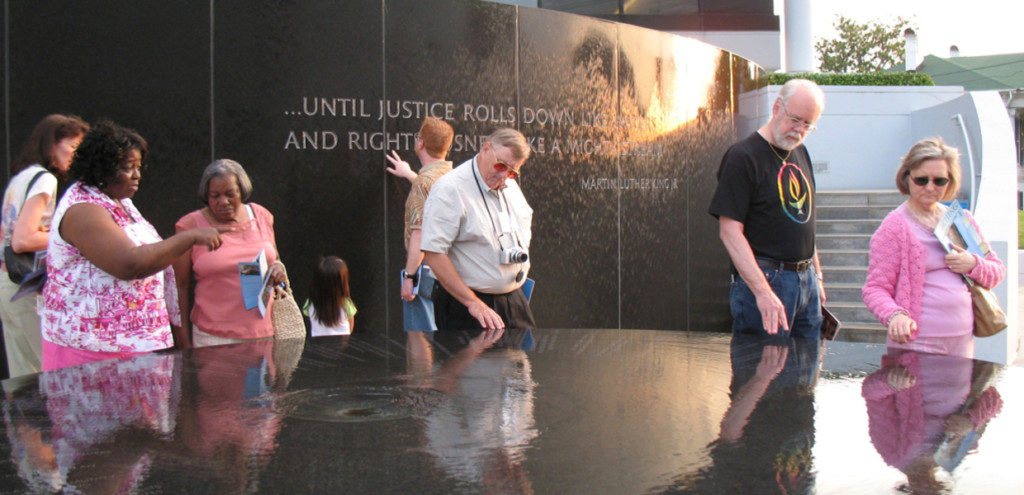
When we think of the civil rights movement, we usually think of Dr. Martin Luther King Jr., Malcom X, Rosa Parks and Nelson Mandela. Rarely do we think of the ones who may have been overlooked or died in the process of fighting for basic human rights. The Civil Rights Memorial in Montgomery is dedicated to telling the stories of the several hundred activists who died fighting for human rights.
The center highlights 40 martyrs (including children) who died due to racially-motivated hate crimes in the civil rights movement. I went to the Memorial for the first time with 17 other AUM students and faculty with SPLC on Campus. The first thing I noticed were the black walls covered with black and white photos of confederate flags, police dogs attacking black men and women, signs calling for integration, and pictures of people I never heard of who fought for the rights I have today. As a black woman living in Montgomery, it was chilling to go through and read the stories of those on the wall, especially when I realized some were my age when they died. I knew a lot of the cities that these murders took place in and walked through the very streets that people died on in the fight for equality.
Michael Donald was a black teenager residing in Mobile. He was returning home from buying cigarettes for his sister when two Ku Klux Klan members, 26-year-old Henry Hays and 17-year-old James Knowles spotted him. They kidnapped 19-year-old Donald, beat him and lynched him in 1981. Samuel Lebanon Younge Jr. served in the United States Navy for two years until he was medically discharged. He attended Tuskegee University and was an active member of the Student Nonviolent Coordinating Committee and a leader of the Tuskegee Institute Advancement League. During his time at Tuskegee, he participated in the Selma to Montgomery march, various protests against segregation, and was arrested for trying to drive a group of African-Americans to get registered to vote in Lee County. The 21-year-old’s efforts came to an abrupt stop when he was shot in the back of the head for using a “white only” bathroom in 1966. Younge became the first black college student to be murdered for his civil rights’ efforts.
After reading the various stories of Emmitt Till, Medgar Evers, Paul L. Guilhard and others, we were directed into the theatre for an emotional, short film. Emmitt Till’s mother stuck out the most during the film because of her refusal to let her son die in vein. Till was 14 years old when he was lynched in Mississippi after being falsely accused of flirting with a white woman. I had heard Till’s story before, but not in the manner that the video at the Memorial presented it. Hearing his mother say that she wanted an open-casket so the world could see what racism did to her son brought tears to my eyes. I thought about the amount of strength she had to not only have looked at her son’s mutilated body, but to show it to the world. The film came to a close and reminded us that we must not simply remember the civil rights movement, but dedicate ourselves to the cause.
After a hopeful and inspiring ending to the film, we were then directed into another room with walls filled with color symbolizing the present-day civil rights movement. People who have died due to various hate crimes beginning in the 90s are honored in this segment of the memorial. A portion of the wall has the quote “Human dignity equals human rights,” displayed. Our tour guide, Joseph E. Williams, informed us of all the efforts and research SPLC does to ensure tolerance and equality is given to all people, including the Emmitt Till Unsolved Civil Rights Crimes Reauthorization Act in 2016. By reauthorizing this act, research can be done to reopen cold cases and seek justice for those involved.
After a question-and-answer session, Williams invited us to join the “Wall of Tolerance” in which you sign a digital pledge to “take a stand against hate, injustice, and intolerance.” According to Williams, there were 892 known hate groups in America in 2015, in 2016 that number increased to 917. These numbers increased have increased since President Trump has been in office and is about 100 fewer hate groups than when former President Obama was elected in 2011. Since the election, there has been a 197 percent increase in anti-Muslim groups. In 2015, there were 34 anti-Muslim hate groups but that number has jumped to 101 in 2016. These numbers suggest that there is a correlation between presidential candidates and hate group creations. Most of the hate against blacks and Muslims are happening in grade schools. This reminded me that the work of the martyrs is not finished, and we must all display tolerance in order to honor them. With this in mind, I signed my own name to the “Wall of Tolerance.”
With inspiration in my heart and a sense of hope, we were directed to the fountain outside of that features the 40 martyrs name on a black circular fountain. Behind it, there is a black wall with a quote from Dr. Martin Luther King Jr. “…until justice rolls down like waters and righteousness like a mighty stream.” A banner hung in the background saying, “the march continues” and gave me a sense of purpose. I realized at the end of the tour each one or us have the potential to be like the martyrs. We are all individuals who can take small actions to make a huge difference because human dignity equals human rights.
By Jacqualyn Woods
